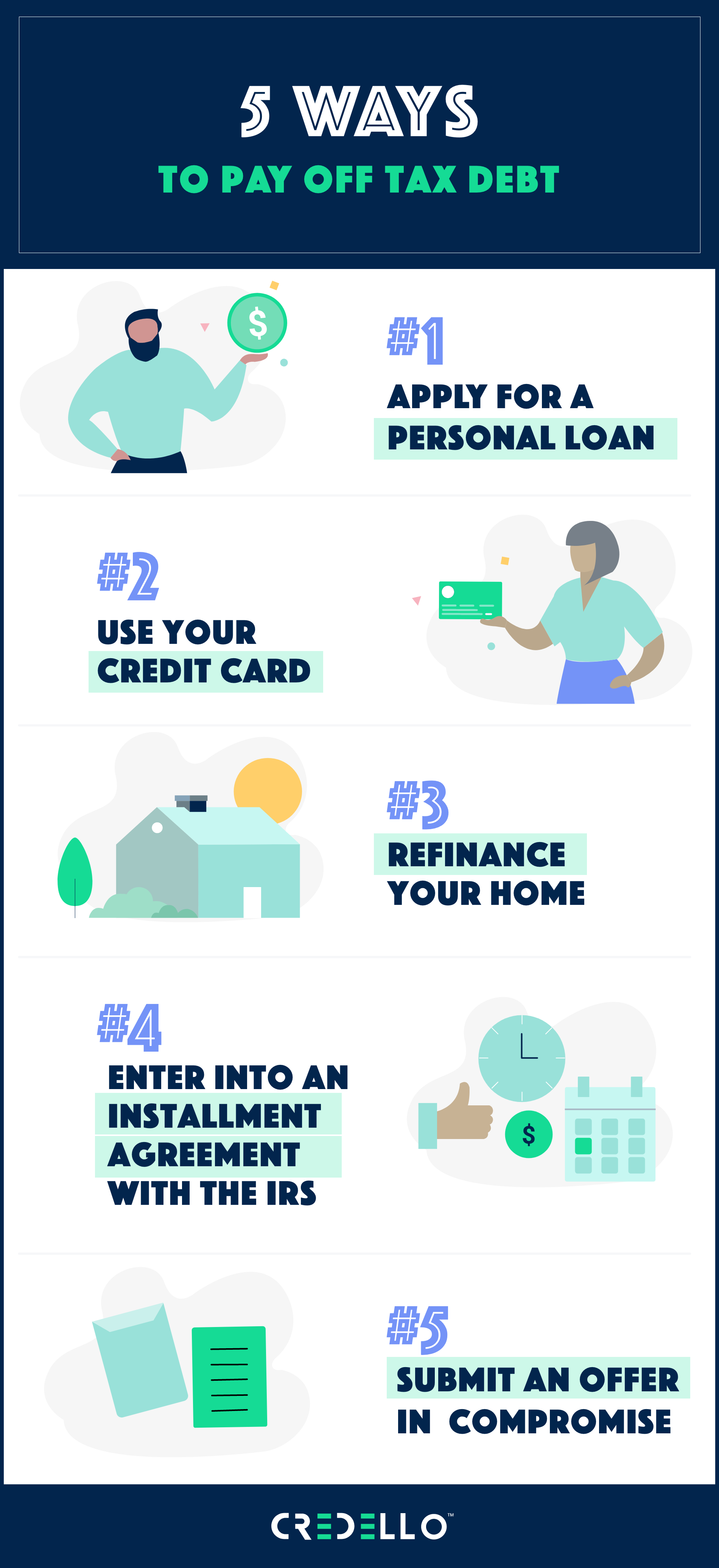How to Pay Off Tax Debt
About Kevin
Kevin is a former fintech coach and financial services professional. When not on the golf course, he can be found traveling with his wife or spending time with their eight wonderful grandchildren and two cats.
Read full bio
At a Glance
There are multiple tax debt payment options, but you’ll want to select the one that is best for minimizing your penalties and interest payments. Time is a factor here because your tax debt increases every day that you don’t submit a payment. It’s critical then to make a decision on which option you use to get out of tax debt as fast as possible.
Option #1: Apply for a personal loan
The IRS charges 5% interest on unpaid taxes. They also add between 0.5% and 25% in additional penalties. Depending on your credit score, personal loans to pay off tax debt could have an interest rate higher than 5%. Eliminating the penalties more than makes up for that.
Here’s what you need:
- Employment information
- Bank account statements
- Credit report
- Collateral (for secured loans)
- Personal ID
Related: How to apply for a personal loan
What are the advantages and disadvantages?
Your loan payments will increase your monthly overhead, but you won’t have to worry about the IRS garnishing wages, i.e. taking money directly out of your paycheck—or seizing your property.
Learn more: Should You Use a Personal Loan to Pay Taxes?
Option #2: Use your credit card
This option depends on your credit card interest rate and how desperate your situation is. Using credit is a good option if you’re paying off tax debt with a low-interest credit card. It’s generally not a good idea to use debt to pay off debt, but it could be your only choice if you’re facing wage garnishments or asset seizures.
Here’s what you need to use credit:
- Credit card
- Credit limit to match tax debt
What are the advantages and disadvantages?
Your credit card’s interest rate may be higher than the interest and penalties combined on your tax debt. If so, you’re better off setting up an IRS installment plan (Option #4).
Option #3: Refinance your home
You might want to refinance your mortgage even if you don’t use the money to pay back taxes. If interest rates stay low, it could be a win-win. For home equity lines of credit—or HELOCs—the prime rate is a mere 3.25%.
Here’s what you need to refinance your home:
- Pay stubs
- Tax returns
- Credit report
- Statements of outstanding debt
- Statement of assets
What are the advantages and disadvantages?
A lower interest rate could save you thousands of dollars on the final purchase price of your home, but you’re also borrowing additional cash to pay off your outstanding tax debt. That may actually increase the amount of your mortgage payment.
Option #4: Enter into an installment agreement with the IRS
This should be a distant fourth option if you can’t obtain financing or credit for paying off tax debt. The IRS, despite being the administrative body for tax collection, doesn’t actually have the power to waive interest and penalties. Installment plans often take years to complete.
Here’s what you need to enter into an installment agreement:
- Tax debt of less than $50,000
- Valid email address
- Social Security or tax ID number
- Bank account to debit payments from
What are the advantages and disadvantages?
An installment agreement is not going to eliminate interest and penalties. On a positive note, if you make higher monthly payments, you will minimize your overall liability.
Option #5: Submit an Offer in Compromise
As of June 19, 2024, the application fee for an IRS Offer in Compromise is $205. You can apply for this option if all your current taxes are paid and you can prove a financial hardship.
Here’s what you need to submit an Offer in Compromise:
- All tax returns filed
- All estimated taxes for current year made
- All current quarterly payments made (for business owners)
- Proof of inability to pay tax debt
What are the advantages and disadvantages?
An Offer in Compromise is great if you can get one, but you’re likely wasting your time and money applying. The IRS typically only grants an OC when there’s been a documented tragedy or medical event that makes payment of the full tax debt unlikely.
FAQs
If you’re facing a large tax debt and know you won’t be able to pay it back, making a settlement deal with the IRS might be your best option. You’ll need to submit an Offer in Compromise request that cites your financial hardship and inability to pay. If approved, you may be able to knock your large tax debt down into a smaller, more manageable amount.
There are several tax debt payment options that you can use on your own without making a deal with the IRS. For example, taking out a loan to pay tax debt or using a credit card are options that don’t require you to enroll in a plan with the IRS. However, you’ll still want to make regular payments on whatever method you choose to get yourself out of debt.
When the IRS is breathing down your neck, you want to know how to pay off tax debt fast. Often, shifting the burden of tax debt to a credit card or personal loan is the fastest way to get the IRS off your back. Of course, you’ll still need to repay the amount owed, but you’ll avoid IRS penalties and fees, thereby lowering your overall debt burden quickly.
Using a loan to pay tax debt makes sense if your credit score is high enough to get a great interest rate. Paying off tax debt using a personal loan also means you’ll avoid IRS penalties and can repay your debt by making consistent monthly payments.
If you can’t pay your taxes on time, you may qualify for a form of tax debt relief. This is designed by the IRS to help lower a taxpayer’s tax bill. There are several types of programs available, typically in the form of payment plans or partial or full debt settlement. You may qualify for a number of reasons, but it’s important to act fast if you need assistance.
Learn more: What is tax debt relief?










